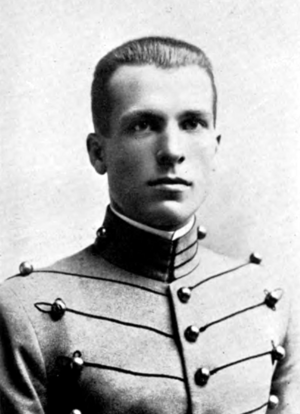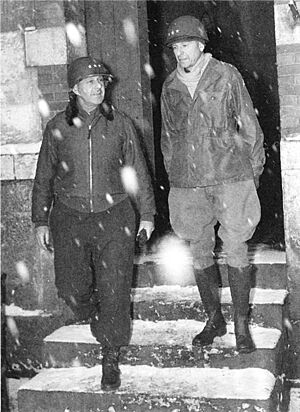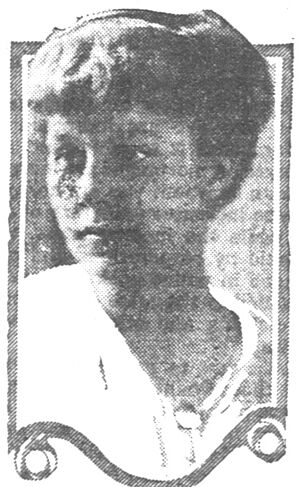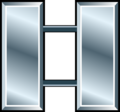Alexander Patch facts for kids
Quick facts for kids
Alexander Patch
|
|
|---|---|
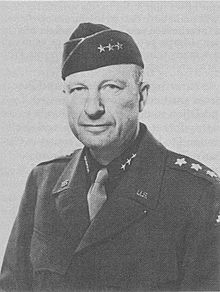
Alexander "Sandy" Patch, pictured here as a lieutenant general, in August 1945
|
|
| Birth name | Alexander McCarrell Patch |
| Nickname(s) | "Sandy" |
| Born | November 23, 1889 Fort Huachuca, Arizona Territory, United States |
| Died | November 21, 1945 (aged 55) Fort Sam Houston, Texas, United States |
| Buried |
West Point Cemetery,
West Point, New York, United States |
| Allegiance | |
| Service/ |
|
| Years of service | 1913–1945 |
| Rank | |
| Service number | 0-3589 |
| Unit | |
| Commands held | 3rd Machine Gun Battalion 1st Battalion, 18th Infantry Regiment 47th Infantry Regiment Americal Division XIV Corps IV Corps Seventh Army Fourth Army 106th Cavalry Regiment |
| Battles/wars | Pancho Villa Expedition World War I World War II |
| Awards | Army Distinguished Service Medal (3) Navy Distinguished Service Medal Bronze Star |
General Alexander McCarrell Patch (November 23, 1889 – November 21, 1945) was a brave and important United States Army officer. He fought in both World War I and World War II, becoming a high-ranking general.
During World War II, he led U.S. Army and Marine Corps troops in the Guadalcanal Campaign in the Pacific Ocean. Later, he commanded the Seventh Army on the Western Front in Europe.
Known as "Sandy," General Patch returned to the U.S. in August 1945. He took charge of the Fourth Army in Fort Sam Houston, Texas. He passed away three months later at age 55. His health had been badly affected by his time fighting in the Pacific earlier in the war.
"Sandy" Patch and Lucian Truscott were special. They were the only two U.S. Army officers in World War II to lead a division, a corps, and a field army. After his death, he was given a higher rank in July 1954, becoming a four-star general.
Contents
Early Life and Military Beginnings
Alexander Patch was born in Fort Huachuca, Arizona Territory, and grew up in Pennsylvania. His father was a former cavalry officer and a graduate of West Point. His mother was Annie Moore Patch.
Patch had German, Scottish, and Irish family roots. He studied at Lehigh University for a year. Then, in 1909, he got into West Point, a famous military academy. He first wanted to join the cavalry. But he realized it was becoming less important. So, he chose the Infantry Branch of the United States Army.
He became an officer on June 12, 1913. He was ranked 75th in his class of 93 students.
First Assignments and World War I
Patch's first job was with the 18th Infantry Regiment in Texas City, Texas. He later fought in the Pancho Villa Expedition in Mexico in 1916. He was then promoted to first lieutenant. In November 1916, he married Julia A. Littell. She was the daughter of an army general.
In June 1917, the U.S. joined World War I. Patch became a captain and was sent overseas with his regiment. They joined the American Expeditionary Forces (AEF) on the Western Front. He stayed there until November.
He then went to a Machine Gun School in England. He commanded the 3rd Machine Gun Battalion. After that, he directed the U.S. Army's Machine Gun School.
Towards the end of 1918, he returned to the 18th Infantry. He fought in major battles like the Second Battle of the Marne and the Meuse–Argonne offensive. This was the largest battle in U.S. Army history. His strong leadership was noticed by Colonel George C. Marshall. The war ended on November 11, 1918. By then, Patch was a lieutenant colonel.
Between the World Wars
After World War I, Patch returned to the United States in May 1919. He chose to stay in the army as a professional soldier. He spent four years at Fort Benning, Georgia, and Washington, D.C..
He then became a professor of military science at Staunton Military Academy in Virginia. He held this job twice, from 1925–28 and 1932–36. He also attended important military schools. These included the U.S. Army Infantry School and the U.S. Army Command and General Staff School. He graduated with honors from the latter.
He served with the 3rd Battalion, 12th Infantry Regiment. Then, he attended the United States Army War College in 1931. He helped change the army's structure. He worked on transforming the old "square division" into the "triangular division."
In November 1940, he became a colonel. He took command of the 47th Infantry Regiment. George C. Marshall, who was now the U.S. Army Chief of Staff, remembered Patch's leadership. Marshall promoted Patch to brigadier general in August 1941. He sent him to Fort Bragg, North Carolina, to train new soldiers.
World War II: Leading Troops to Victory
Fighting in the Pacific
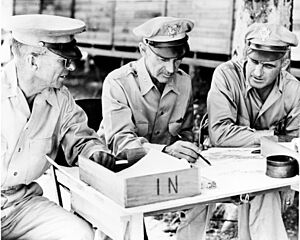
Patch was promoted to major general in November 1941. He was given command of Task Force 6814. This was a group of two infantry regiments. The next month, Japan attacked Pearl Harbor. Soon after, Germany declared war on the U.S. This brought the United States into World War II.
Patch was sent to the Pacific Ocean. He arrived in Noumea in March 1942. His job was to organize defenses for New Caledonia. On the way, he got pneumonia. After recovering, he formed many units into the Americal Division. This name came from "American, New Caledonian Division."
The Americal Division first fought in the Guadalcanal campaign in December 1942. They took over from the tired 1st Marine Division. In January 1943, Patch took command of the XIV Corps. He was put in charge of the entire attack on Guadalcanal.
Patch personally led his troops in a dangerous attack. This was the Battle of Mount Austen, the Galloping Horse, and the Sea Horse. They captured fortified hills from the Japanese forces. Thanks to Patch's leadership, the Japanese were driven from Guadalcanal by February 1943.
Training and Moving to Europe
After the victory at Guadalcanal, Patch's health was poor. He had suffered from pneumonia, dysentery, and malaria. So, George Marshall called him back to the U.S. After getting better, Patch took command of the IV Corps in May 1943.
That fall, he led the Oregon Maneuver. This was a huge training exercise in central Oregon. About 100,000 soldiers took part. It was the largest training exercise of World War II. It helped prepare American units for fighting in Europe and the Pacific. In early 1944, he took his corps overseas to Algiers, Algeria.
Leading the Seventh Army in Europe

In March 1944, Patch took command of the Seventh Army. He took over from Lieutenant General Mark W. Clark. The Seventh Army had been the first American army in Europe during the war. It had landed in Allied invasion of Sicily in July 1943.
Under Patch's command, the Seventh Army prepared for Operation Dragoon. This was an amphibious attack on southern France. The Seventh Army included experienced units from Italy. These were Major General Lucian Truscott's U.S. VI Corps and General Alphonse Juin's French Expeditionary Corps.
On August 15, 1944, Patch led the Seventh Army in Operation Dragoon. Three days later, he was promoted to lieutenant general. He then led the Seventh Army in a fast advance up the Rhône valley. On September 9, 1944, near Dijon, France, they met the U.S. Third Army. This army, led by George S. Patton, had come from Normandy.
The Seventh Army, under Patch, fought bravely in the Vosges Mountains. They cleared strong German forces from the west bank of the Rhine River. They also stopped a German counterattack, Operation Nordwind. One of Patch's commanders, Major General Truscott, praised him. He called Patch "a man of outstanding integrity, a courageous and competent leader."
In the spring of 1945, General Dwight D. Eisenhower offered Patch a special plane. But Patch preferred a smaller plane. He wanted to stay close to his commanders during fast operations. He narrowly escaped danger on April 18, 1945. His small plane was attacked by a German fighter. But his pilot skillfully escaped and landed safely.
Patch remained in command of the Seventh Army until the end of the war in Europe in May 1945. He led the army through the Siegfried Line, across the Rhine, and into southern Germany. By the end of the war, his troops had reached Austria and northern Italy.
In August 1945, Patch returned to the United States. He took command of the Fourth Army. This army was preparing for a possible invasion of Japan. However, Patch was hospitalized with lung problems in November. He passed away a week later.
Personal Life and Family
On November 20, 1915, Alexander Patch married Julia Adrianne Littell. They had two children. Patch faced a terrible personal sadness during the war. His 24-year-old son, Captain Alexander M. Patch III, was killed in action. This happened on October 22, 1944, in France. His son was leading his company at the time. Captain Patch received several awards for his bravery after his death. He is buried in the Epinal American Cemetery and Memorial in France.
General Patch died of pneumonia on November 21, 1945. This was two days before his 56th birthday. He passed away at Brooke General Hospital in Fort Sam Houston, Texas. He is buried at West Point Cemetery in New York.
Legacy: Remembering a Hero
Many places and things are named after General Patch. Kurmärker Kaserne, a military base in Stuttgart-Vaihingen, West Germany, was renamed Patch Barracks on July 4, 1952. This base is now the home of the Headquarters, United States European Command (HQ USEUCOM). There is also a middle school and a former high school named after him at Patch Barracks.
The U.S. Navy transport ship USNS General Alexander M. Patch (T-AP-122) was also named in his honor. In southeastern France, a road called Boulevard Patch leads to Pampelonne Plage. This road is also named for him.
Patch was given a posthumous (after death) promotion to full general on July 19, 1954.
Major Commands Held
- Task Force 6814: November 1941 to May 1942
- Americal Division: May 1942 to January 1943
- XIV Corps: January 1943 to April 1943
- IV Corps: May 1943 to March 1944
- Seventh United States Army: March 1944 to August 1945
- Fourth United States Army: August 1945 to November 1945
Awards and Decorations
General Alexander M. Patch received many awards for his service:
- Army Distinguished Service Medal (with two Oak Leaf Clusters)
- Navy Distinguished Service Medal
- Bronze Star Medal
- Mexican Border Service Medal
- World War I Victory Medal (with three battle stars)
- American Defense Service Medal
- American Campaign Medal
- Asiatic-Pacific Campaign Medal (with two service stars)
- European-African-Middle Eastern Campaign Medal (with three service stars)
- World War II Victory Medal
- Companion of the Order of the Bath (United Kingdom)
- Commander of the Légion d'honneur (France)
- Croix de Guerre (with palm) (France)
- Order of Leopold II, Grand Cross (Belgium)
- Croix de Guerre (with palm) (Belgium)
- Order of Abdon Calderón (Ecuador)
Images for kids


